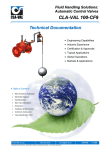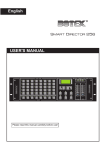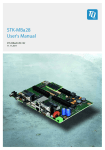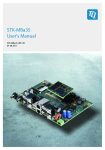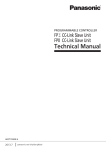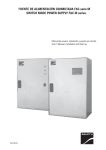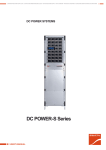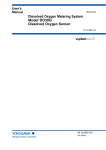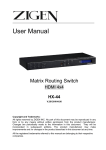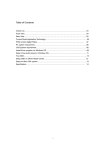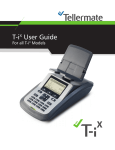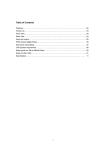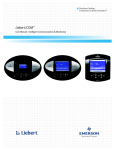Download english
Transcript
SWITCH MODE POWER SUPPLY FAC P series. User, installation and start up manual. EK328J01 SAFETY WARNINGS . ..................................................................................................... 8 -2- We would like to thank you in advance for the trust you have placed in us by purchasing this equipment. Read these instructions carefully before starting up the equipment and keep them for any possible future use. We remain at you entire disposal for any further information or any query you should wish to make. Yours sincerely. SALICRU According to our policy of constant evolution, we reserve the right to modify the specifications in part or in whole without forewarning All reproduction or third party concession of this manual is prohibited without the previous written authorization of our firm. -3- General contents. 1.- FAC DRAWINGS (see figures 8 to 14). 2.- LEGENDS OF THE FAC DRAWINGS. 3.- SAFETY WARNINGS . 4.- DESCRIPTION AND BLOCK DIAGRAM. 5.- PRESENTATIONS, VERSIONS AND NOMENCLATURE. 5.1.- Presentations. 5.2.- Versions. 5.3.- Nomenclature. 5.3.1.- Module. 5.3.2.- System. 5.3.3.- Structure system diagram with «n» modules in parallel with protections. 6.- EQUIPMENT RECEPTION. 6.1.- Reception and unpacking. 6.2.- Storage. 7.- INSTALLATION. 7.1.- Look after your own safety. 7.2.- To keep in mind . 7.3.- Connection to AC mains, terminals (X1), (X2), (X3) and (X4). 7.4.- Connection with the batteries (Only models with extended autonomies), terminals (X11), (X12) and (X47), (X48). 7.4.1.- Version (B). Batteries of the client’s property, installed externally to the (Sfac). 7.4.2.- Version (B ***´), supplied with batteries built in a separate cabinet or rack from the (Sfac). 7.4.3.- Version (B 0´/***´). Batteries of the client’s property, with foreseen space. 7.5.- Connection of the DC supply to the loads, terminals (X6), (X9) or (X6A.. X6*) and (X9A.. X9*). and protective earth bonding terminal (X10) . 7.6.- Main protective earthing terminal (X5) 7.7.- Relay interface. 7.7.1.- Relay interface in DB9 connector or terminals strip (X32), see figures 2.1 or 2.2. 7.7.2.- Relay interface in terminals strip (X32), see figure 2.3 (only equipments with MS-101 optional). 7.7.3.- Relay interface in terminals strip (X32), see figure 2.4 (only equipments with MS-102 optional). 7.8.- Serial interface RS-232 or 485, DB9 connector (X31). 7.9.- Temperature probe/battery floating voltage. DB9 connector (X34) or terminals strip (X25*). 7.10.- Room ambient temperature probe. Terminals strip (X25*), (equipments with MS-101 only). 7.11.- Terminals strip, auxiliary contacts of the (Sfac) protections. 7.12.- Terminals strip (X43), auxiliary contacts of the battery cabinet protections. 8.- START UP AND SHUTDOWN OF THE FAC. 8.1.- Start up of the (Mfac) or (Sfac) (First start up or after a complete shutdown). 8.1.1.- Module (Mfac). 8.1.2.- System (Sfac). 8.2.- FAC shutdown (daily operation, if the installation requires it). 8.2.1.- Module (Mfac). 8.2.2.- System (Sfac). 8.3.- Complete FAC shutdown. 8.3.1.- Module (Mfac). 8.3.2.- System (Sfac). -4- 9.- FAC SYNOPTIC. 9.1.- Optical indications. 10.- REPLACING A FAC MODULE IN A SYSTEM (Sfac). 11.- COMMON TECHNICAL FEATURES STANDARD MODULES. 12.- PARTICULAR TECHNICAL FEATURES OF THE STANDARD MODULES. 13.- SYNOPTIC VIEWS, FAC (Mfac) MODULES AND SYSTEMS (Sfac) VIEWS. -5- 1.- FAC DRAWINGS (see figures 8 to 14). 2.- LEGENDS OF THE FAC DRAWINGS. Connection elements: (X1, X4) AC single phase input terminals (R-N) (X1), (X4). (X1, X2, X3, X4) AC three phase input terminals (R-S-T or R-S-T-N) (X1), (X2), (X3) or (X1), (X2), (X3) and (X4). (X5) Main protective earthing terminal, identified with the label . Some equipments has only one point of earth connection - copper bar - (X5) which is used to connect the earth coming from the input and the one coming from the load/s and battery cabinet/s. (X6, X9) DC output terminals (+,–) (for equipments with outgoing distribution only). (X6A.. 6*, X9A.. 9*) DC output distribution terminals (+,–) (the standard has the own terminals of the protections as terminals and only under request the terminal strip with «n» terminals will be available). (X10) Protective earth bonding terminal for load/s and battery cabinet or rack, identified with the label . (X11, X12) Battery terminals (+,–) (for equipments with batteries in whole or in part installed externally from the FAC cabinet). (X13) Protective earth bonding terminal for battery cabinet or rack, identified with the label (X25*) Terminals for room ambient temperature probe. Equipments with MS-101 only, and terminals for temperature probe/battery floating voltage. Equipments with MS-101 or MS-102 only. (X31) DB9 connector, communication channel RS-232 or 485. (X32) DB9 connector or terminal strip, relay interface. (X34) DB9 connector, for temperature probe/battery floating voltage. (X35) DB25 or RJ-48 connector. Exclusive use for Service and Technical Support (S.T.S.) (only in FAC with led synoptic). (X40) Auxiliary contact terminals, general input protection «GENERAL INPUT». (X41A.. X41*) Auxiliary contact terminals, individual input protections per each FAC module «INPUT MODULE». (X42) Auxiliary contact terminals, battery protection of the FAC cabinet «BATTERIES». (X43) Auxiliary contact terminals, battery protection of the battery cabinet or rack «BATTERIES». (X44A.. X44*) Auxiliary contact terminals, individual output protections per each FAC module «OUTPUT MODULE». (X45) Auxiliary contact terminals, general output protection «GENERAL OUTPUT». (X46) Auxiliary contact terminals, general output protection of the outgoing distribution «GENERAL DISTRIBUTION». (X46A.. X46*) Auxiliary contact terminals, output distribution protection «OUTPUT DISTRIBUTION». (X47, X48) Battery terminals (+,–) of the battery cabinet or rack. Protection and manoeuvres elements: (F1) Tubular fuse, AC input protection of the module (FAC with 2U height only). (Q1) General input protection «GENERAL INPUT». (Q1A.. Q1*) Individual input protections of each FAC module «INPUT MODULE». (F2) General output protection «GENERAL OUTPUT». (F2A.. F2*) Individual output protections of each FAC module «OUTPUT MODULE». (F3) Battery protection of the FAC cabinet «BATTERIES*». (F6) General output protection of the outgoing distribution «GENERAL DISTRIBUTION». (F6A.. F6*) Output distribution protection «OUTPUT DISTRIBUTION». (F8) Battery protection of the battery cabinet «BATTERIES*». Usually all the protections used in the equipment are switches with fuses (F*), except for the input switches are circuit breaker protections (Q*). Under customer’s request, it can be changed by other type, so then the description done in this manual can have deviations in respect to the equipment. Operate responsibly and in consequence, attending to the protection type of your equipment. -6- Control panel, optical indications depending on the model: (a) Led «ON». (b) Led «Alarm». (c) Led «Floating voltage». (d) Led «Discharge». Control panel, LCD and keypad (equipments with LCD panel only. Not available in FAC 2700 module): (e) Display. (f) Key «ON» in led synoptic or «ENT/ON» in LCD synoptic. (g) Key «OFF» in led synoptic or «ESC/OFF» in LCD synoptic. (h) Move forward key« ». (i) Move back key « ». (j) Move to right key « ». (k) Move to left key « ». Abbreviations and different elements: (AS) / CA Module handle or marksman and (MS-102). / Lifting ring to elevate the equipment. (BAT.) Battery cabinet. (CL) Cabinet lock with or without key locking, either standard or special. (FAC) Spanish acronym for «Switch Mode Power Supply ». It is used generically to refer the product. (Mfac) FAC module, rectifier unit. (MS-101) Analyser monitor with 20x2 characters (See user’s manual EK314*02) (MS-102) Analyser monitor with 40x4 characters(See user’s manual EK399*02). (PA) Front door of the cabinet. (PB) Fixing elements. (PR) Cable glands. (RC) Slot to enter the cables. (RV) Cooling grid. (Sfac) FAC cabinet system. (TB) Terminal cover. Analyser fixing screw (MS-101) or (MS-102). (TF1) Module fixing screw and cover terminals (TB) and top socket (TZ). (TF2) Top socket (two per cabinet, delivered inside the same). (TZ) SIMBOLOGY USED IN THIS MANUAL AND/OR ON THE EQUIPMENT.. «Warning» symbol. Carefully read the indicated paragraph and take the stated prevention measures. «Danger of electrical discharge» symbol. Pay special attention to it, both in the indication on the equipment and in the paragraph referred to this user’s manual. «Main protective earthing terminal» symbol. Connect the earth cable coming from the installation to this terminal. «Protective earth bonding terminal» symbol. Connect the earth cable from the loads or battery cabinet to this terminal. «Notes of information» symbol. Preservation of the environment. The presence of this symbol in the product or in their associated documentation states that, when their useful life is expired, it will not be disposed together with the domestic residuals. To avoid possible damages to the environment, separate this product from other residuals and recycle it suitably. The users can contact with their provider or with the pertinent local authorities to be informed on how and where they can take the product to be recycled and/or disposed correctly. -7- 3.- SAFETY WARNINGS . • Together with the equipment and this «User’s manual», it is supplied information referred to «Safety instructions» (See document EK266*08). Before proceeding with the installation or start up, make sure that you have both sets of information, otherwise request them. It is a must the compliance referred to the «Safety instructions», being the user the responsible of its observance. Once read, keep them for future consults that can arise. PARTICULAR SAFETY WARNINGS. The FAC product described in this User’s manual, has been designed, manufactured and commercialised in accordance with the standard EN ISO 9001 of Quality Assurance. The CE marking states the conformity to the EEC directives in accordance with the following standards: • EN 60950-1: 2001. IT equipments. Safety. Part 1:General requirements. • EN 61204-3:2000. Power supplies of low voltage, with D.C. output Part 3: Electromagnetic compatibility. • ETS 300386-2. Electromagnetic compatibility requirements for telecommunication equipments. Part 2 Product family standard. L.V. SAFETY: • The FAC is an electrical equipment with protection of Class l. It is essential to connect the protective earth cable to the right terminal in order to be protected against electrical shocks. The protective earth cable must be separated from the Telecommunication network, (to which the output of the DC power supply will be connected). • The earth connection is guaranteed although the input protections trip. • The equipment has an input protection against surges voltages of 5 kV (impulses of 8/20 µs). If higher surges are expected, additional protection must be used. • The insulation distances provide a pollution degree 2 (P2), in accordance with the standard HD 625.1. S1 (IEC 664-1mod.): nonconductive pollution, except for occasional condensation. Additional protections must be added for highly polluted environments (with conductive particles) or with frequent humidity condensation. • The equipment has a thermal protection device to protect the power semiconductors. This device breaks the operation of the system from a certain temperature; when cool the power supply restores the feeding. Make sure that this function is not dangerous when the voltage is restored suddenly. • The safety level at the output of the FAC circuit is a Telecommunication Network Voltage Circuit. According to the referred standard EN 41003, the output requires the same insulation features as Telecommunication Network to which it will be connected. Make sure that the rest of the installation connected to the output of the system must also comply those requirements. -8- 4.- DESCRIPTION AND BLOCK DIAGRAM. Input filter PFC 1 DC / DC Converter Rectifier Output Filter AC INPUT DC OUTPUT Control PFC 1 Input Power Supply DC / DC Control Monitor Program. Output Power Supply Static switch Micro. Control Batteries Fig. 1.1. Module block diagram of FAC P series. The operating principle of the FAC P series, is based in the conversion of the input alternating current, previously conditioned by a line filter, to direct current after being transformed, rectified and controlled. By means of fast transistors of high performance and starting from a 385 V DC, the DC / DC converter generates an alternating current at 40 kHz, which is after rectified with ultrafast diodes and conditioned through an efficient system of filtering. A special power transformer, isolates galvanically the input from the output, and reduces the alternating voltage to the required value to generate the wanted DC voltage. The output voltage and current are controlled by pulse width modulation in the transistors located in the primary winding of the transformer. A static switch is located at the output of the FAC, and it is in charge of disconnecting the batteries when they reach the end discharge voltage, regardless if the batteries are supplied in the same FAC cabinet or not, in the case of power supplies with autonomy. The vital constants of the power supply are digitally controlled through a microprocessor, which is the responsible to manage the displayed adjustments and measures, in case it has a synoptic with LCD panel (not available for FAC 2700). All the FAC have the same operating, regardless the format, power and input-output voltages. Thanks to its parallelable feature and the capacity to store energy in a battery set and to have high autonomies, makes the FAC P series a product range highly suited for different high technology applications. -9- 5.- PRESENTATIONS, VERSIONS AND NOMENCLATURE. 5.1.- Presentations. Each FAC unit (Module (Mfac)) is manufactured as a separate unit and assembled in 19’’ or metric sub-racks. They are provided with power terminals and DB9 connectors for the communication channels, or with only one plug-in connector that groups all the connections, less the FAC 2700, which is only available in the plug-in version and it is also the only one with vertical format. Each FAC 2700 are not connected directly to the back-plain of the system (Cabinet (Sfac)) as it is done in the rest, but rather they are connected to the back-plain located in a 19’’ sub-rack with 6U height, which at the same time it is fixed mechanically to the system (Sfac). Each sub-rack allows to insert up to 6 rectifiers. Each system is able to have a certain quantity of rectifiers connected in parallel or redundant «N+1», depending on: the number of units of the cabinet (height), the rectifier model and the configuration set (included analyser, number and type of protections, outgoing distribution, auxiliary contacts of the protections, ...). Technically the maximum quantity of rectifiers to be connected in parallel is 16 units for (MS-101) analyser and 64 for (MS-102). However, although it is technically possible, each particular case needs a viability study. In the figure 9 is only showed the rear view of the models with terminals, because the plug-in versions are reserved to make modular structures of «n» parallel units and they don’t require any work for their electrical connection. Generally the rectifiers supplied as individual units or systems with only one rectifier, are manufactured with the synoptic with LCD panel, and the led version is reserved for parallel or redundant «N+1» systems with (MS-101) or (MS-102) analyser. Nevertheless it is possible any configuration due to the modularity of the rectifiers and to their independence because they are intelligent, so it allows to manufacture tailor-made equipments for each client and/or application. If also batteries are added, it will be a DC Uninterruptible Power Supply. The figures 10 to 14 show the layout of the elements that configure a power supply in a rack cabinet (System (Sfac)), they are only mere guides, because there are multiple combinations, and the operating of the equipment does not depend on the layout. If any of the referred parts are not in your equipment , omit all references to it, and on the other hand, if it includes elements that are not described in this manual, additional annexes will be edited if necessary. Furthermore, the equipment is delivered duly labelled, so pay attention to it. Two poles fuse-switch are used for the protections of the outgoing distribution, considering the system with floating output voltage. And for other types of connection like positive or negative to ground, the fuse-switch protection will only have one pole. As outgoing distribution terminals will be the own ones of the two poles fuse-switch protections or single pole for the live pole together with a copper bar for the negative or positive, which corresponds to the pole connected to the earth. It is possible to manufacture the (Sfac) with any requirement, so the unit can differ more or less from the standard (Sfac), according to the requirements. By default the input entry cable of the (Sfac) is foreseen bottom of the cabinet and connecting all elements must be arranged next to this area. As a result of individual customer specifications can be manufactured with the entry of cables across the top cabinet. - 10 - 5.2.- Versions. • Basic, as a simple DC power supply. • As a Uninterruptible Power Supply with three possible options: Version (B). Equipment with connection terminals, with external batteries owned by the client. They will be installed and connected by the client, under his responsibility in a cabinet, case or rack. Version (B ***´). Equipment supplied with batteries. Autonomy (***´) according to the purchase order. Version (B 0´/***´). Equipment supplied without batteries, but with the accessories and space to locate them depending on the autonomy/batteries (type - nr - voltage ), requested on the purchase order. The installation and connection of the batteries will be done by the client and under his own responsibility. 5.3.- Nomenclature. 5.3.1.- Module. FAC 1000P-HMELFKT3/230-48-18A «EE90528» Particular specifications of an special equipment «EE». Output current of the module at floating voltage. DC nominal output voltage (*). AC nominal input voltage. 3 Relay interface with 3kV insulation, it replaces the standard one. T External battery measurement. No indication, internal measurement. K External end of autonomy contactor. No indication, internal end of autonomy. F Isolation failure. Only for equipments with floating output (no connection of the positive or negative poles to earth) and the module with LCD panel. Check that the loads connected to the FAC, don not have any connection between anyone of the output poles and the earth, before starting the installation procedure. L Led synoptic. No indication, LCD synoptic. E Plug-in connection type. No indication, through terminals. M Metric format with width 533 mm. No indication 19’’. Disposition: H (horizontal), V (vertical). P FAC series. Model of the module. FAC Spanish acronym of «Switch Power Supply». (*) Reference to earth of the DC output voltage in the modules (Mfac). All the (Mfac) are supplied from factory with floating output voltage (no connection of the positive or negative poles to earth), being the user able to modify it according to the specific application needs. To make it, just connect a cable bridge between one of the output poles and the earth, which at the same time is connected with the frame of the equipment: • Cable bridge between the output positive pole and earth, for connection (–Un). • Cable bridge between the output negative pole and earth, for connection (+Un). Never make this connection out of the terminals of the own equipment. - 11 - 5.3.2.- System. 3FAC 1000P/230-48-54A 120’ «EE90528» Particular specifications special equipment «EE». Autonomy of the system at total output current of the system. Total output current at floating voltage (a system with N+N, the current of the redundant units is not included). 48 Floating DC nominal output voltage (no connection to earth) (**). (–48) Negative DC nominal output voltage (postive to earth). (+48) Positive DC nominal output voltage (negative to earth). AC nominal input voltage. P FAC series. Model of the module. FAC Spanish acronym of «Switch Power Supply». Maximum number of installed modules or to upgrade. Omitted if it is 1. (**) If the positive or negative poles are connected to the earth (reference), the sign of the live pole will be indicated together with the voltage value, for example (–48) for positive to earth or (+48) for negative to earth. When there is not any sign of polarity together with the value of the voltage, it is floating. • Where necessary change the connection type original factory output, must necessarily change the type of protection or protections output, as detailed below: - To output floating, protección two poles. - To output with positive to ground, protection single pole in the negative pole. - To output with negative to ground, protection single pole in the positive pole. - 12 - 5.3.3.- Structure system diagram with «n» modules in parallel with protections. Communication ports. Q1A F2A Q1B F2B Q1 Output distribution. F2 F6A F6 F2* Q1* Output. Input. MS-101 or MS-102. F6B F6* Batteries. F3 End of autonomy contactor. All the references related with the circuit breaker protections are identified with «Q*» and the fuses protections with «F*» in the description of this manual. Furthermore, under request only the components of the system will be labelled following the correspondance between the «documentation and the equipment labelling». When due to specific requirements the foreseen circuit breakers protections in the system are replaced by fuses and particuarly for those equipments with corresponding labelling «documentation-equipment», the acronym «Q» is replaced by an «F» or the «F» by an «Q» maintaining the same numerical order. The block diagram of the figure is an example structure because the number of modules connected in parallel and protections can vary, but in general terms the disposition of them if they are, will follow this block diagram. Fig. 1.2. Structural example of a FAC system with protections. - 13 - 6.- EQUIPMENT RECEPTION. 6.1.- Reception and unpacking. • On receiving the equipment, make sure that it has not been damaged during transport, to know it, the equipment must be unpacked. Otherwise, make all suitable claims to your provider or, short of this to our firm. Also make sure all the data in the nameplate adhered in packing of the equipment, correspond to those specified on the purchase order. If they are not equal, make your claim as soon as possible, with the serial number of the equipment and the references in the delivery invoice. • Having completed the reception, it is better to pack the FAC again until it is commissioned, in order to protect it against mechanical impacts, dust, dirt, etc... • The packing of the equipment has a wooden pallet, cardboard or wooden enclosure depending on the case, corners of expanded polystyrene or polyethylene foam, polyethylene wrap and band. All of them are recyclable materials; therefore if any of them are to be thrown away, they must be disposed in accordance with the applicable laws. It is better to keep the packing in case it has to be used in future. 6.2.- Storage. • The equipment must be stored in a dry, well-cooled place and protected from the rain, water projections or chemical agents. It is better to keep the equipment and/or battery cabinets, as the case may be, in their original packing, as it has been specifically designed to assure the maximum protection during transport and storage. • Some FAC have sealed lead-acid or Nickel-Cadmium batteries, depending on the particular specifications of the purchase order, and they can’t be stored for more than 6 months (see battery recharging period, stated in the packing of the equipment). After this time, charge the batteries till the floating level. The level can be checked in the LCD panel of the synoptic, through the (MS-101) or (MS-102) analysers depending on the available one in your equipment. This means to connect the equipment to the commercial mains and start it up, read the respective chapters. Then pack the FAC in its original packing again, writing down the new date of battery recharge on the respective label. Do not store the equipments where the ambient temperature is over 40º C or below -20º C, because the electrical characteristic of the batteries might be affected. - 14 - 7.- INSTALLATION. • Check the safety warnings (see document EK266*08). • Check that the data in the nameplate are those ones required for the installation. • A wrong connection or manoeuvre, can make damages to the FAC and/or to the connected loads. Read the instructions of this manual carefully and follow the stated steps in the same order. • In the description of this manual there are references to the connection of terminals and switch manoeuvres or protections that some models only have. Omit the references of those elements that are not available in your equipment. • Some (Sfac) are supplied in cabinets with the front side closed by a door (PA) that can be completely solid, glass or with a transparent window and equipped with a lock (CL) with standard or special key for the mechanism. To do any installation, commissioning or maintenance operating, that door must be opened through that mechanism. When the corresponding operations are finished, for those equipments with available mechanism, the door (PA) should be closed and blocked by using the available it and keeping the key in a save place. • In models without front door (PA) provides a cover (TB) for terminals. Remove the cover to proceed with the work of connection and place it once again finished them. • In the cabinets with removable battery trays, there is danger of overturning the cabinet when pulling out the battery trays, so the operator in such case can suffer serious injuries. Therefore it is a must to adhere warning labels in visible areas, advertising the need to fix the cabinet to the floor or the wall with elements that guarantee a total and permanent solidity. • All systems configured with (Mfac) 2700 VA vertical, is delivered with the modules packaged and placed on a tray of batteries inside the cabinet, secured by straps. Once located and locked the cabinet to the floor, cut the straps that hold the modules, remove the packaging and placing them in the sub-rack starting from the upper left corner. Finally fix the chassis through the corresponding screw (TF2). 7.1.- Look after your own safety. • As this equipment is protected against electrical shocks of class I, it is essential to install the protective earth cable to the terminal or copper (X5) identified with the label . • All the connections of the equipment, including the control ones (communication ports, auxiliary contacts, ...), should be made with the switches and the protections in rest mode and the mains disconnected (mains switch of the FAC turned «Off»). • Never forget that a FAC with batteries is a generator of electric energy, so the user must take all the cautions against direct and indirect contacts. • Generally the batteries are installed in the same cabinet as the (Mfac), so the terminal strip for the batteries will not be available in that cabinet. These terminals will only be available in those equipments with external batteries in one or more cabinets or racks in order to enable the connection of the system with the batteries. Take cautions with the battery terminals, as there is hazardous voltage between the battery terminals and the earth, and it will be higher as higher is the battery voltage. • The manipulation and battery connection must be made or supervised by staff with battery knowledge. In equipments with autonomy 0’ or 0’/*, the acquisition, installation and battery connection will be always done by the end user and under his own responsibility. The data referred to the quantity of batteries, capacity and voltage are stated in the battery label adhered beside the nameplate of the equipment, respect strictly those data, the polarity connection of the batteries and the connection diagram supplied with this documentation. - 15 - • Due to the percentage of the weight of the batteries in front of the system one, they are supplied packed separately from the metallic cabinet or rack that will house them, so there is a posterior labour of placing and connecting them with the supplied accessories. When the cabinet is placed in the foreseen location, and all the covers have been removed and it is fixed to the floor or to the wall, proceed to place the batteries with the same disposition as states the supplied annex documentation referred to the disposition and connection of the batteries. Start from the lower tray in order to seat it and go to the next level as soon as the tray is completed. Make sure that once the battery tray is completed, it is pushed into the cabinet again, this way we will avoid mechanical efforts over the chassis, which can twist the structure. Once the placement works are finished, connect them according to the same annex documentation and taking care of both not extracting more than one tray and respecting the safety instructions of the battery part stated in the manual EK266*08. 7.2.- To keep in mind . • The cross section of the input and output cables shall be sized from the nominal currents stated in the nameplate, and respecting the Local and/or National Electro-technical regulation of Low Voltage. • The cable glands (PR) build in the metallic structure, are the stated ones to fix correctly the connection cables with the right cross section size determined by the National Electro-technical Regulation of Low Voltage and in accordance with the currents of the equipment. If the cross section needs to be modified, this should be done from a separate distribution panel, maintaining the stated cross sections from the equipment to the distribution panel. Some FAC have slots (RC) to make easy the entry and outlet of the connection cables. Modules with terminals and DB9 connectors (Mfac). • The fitter must install circuit breaker protections in the power supply mains to the (Mfac) and in the power supply line to the loads. Both protections with at least the stated current in the nameplate and with characteristic D and C respectively. Make sure that both are turned «Off». • Check the input fuse (F1) is fitted. In case, it is blown, replace it with another one of the same size and characteristic as shown in the label under the fuse holder, taking care on the format and dimensions (FAC 1000P only). • All the connections are made from the rear side (see figure 9). Parallel or redundant N+N systems in cabinet (Sfac). • By default the connections for systems in cabinet, are done from bottom in the same, by entering the cables through the cable glands (PR) or through the slot (RC) (see figures 10 to 14). Previously, the terminal cover (TB) must be removed or open the door (PA), to have access to all connection elements. • All the protections (breakers and/or switches) of the system must be turned «Off». • As a result of the tailored manufacturing of the (Sfac), the terminal strip may vary from one equipment to another, depending on the type and number of devices that it includes. The drawings in figures from 10 to 14 of this manual are the most common and as consequence of it the terminal strip too. It doesn’t mean that your equipment will have all the devices and terminal strips, but in case it has them, that would be the order. Follow the connection instructions of the elements included in your equipment only and omitting any other description. • When the connection of the system has been finished, it will be placed and to fix the covers socket (TZ) of the frontal and back of each cabinet, delivered inside the same through the screws (TF2) delivered along with lids. - 16 - 7.3.- Connection to AC mains, terminals (X1), (X2), (X3) and (X4). • The earth must be connected to the terminal or stud fixed to the chassis (X5) and identified with the label , make sure that it has been done before connecting the input power supply cables to the (Mfac) or (Sfac). • Connect the power supply cables of the (Mfac) or (Sfac) to the input terminals (X1), (X4) in single phase equipments or (X1), (X2), (X3) and (X4) in three phase ones, respecting the phase/s sequence and neutral, stated in the labelling of the equipment. It is essential to have the neutral connected in the three phase systems with star configuration. 7.4.- Connection with the batteries (Only models with extended autonomies), terminals (X11), (X12) and (X47), (X48). • Any equipment with autonomy, means the connection of the (Sfac) with the batteries, except for those ones that the system has the batteries built in, so in such case any operating referred to it will be omitted because the terminals (X11), (X12) will not be available. For all the other versions with terminals for battery connection, proceed according to the case: 7.4.1.- Version (B). Batteries of the client’s property, installed externally to the (Sfac). • The batteries will be installed and connected by the client and under his own responsibility, in one or more cabinets or racks, respecting the «Safety instructions» (see document EK266*08). • Make sure that the battery protection (F3) is turned «Off». • A circuit breaker or fuse-switch must be installed in each battery cabinet or rack, in order to break the two DC poles that supply the (Sfac), in case of any accidental circumstances. • Connect the terminals (X11), (X12) and (X10) of the (Sfac) with the battery terminals of each cabinet or rack, make sure both the above stated protection is turned «Off» and the colour of the cables (red for (+), black for (–) and green-yellow for the protective earth bonding ) are respected, as well as the polarity stated in the labelling of the equipment. 7.4.2.- Version (B ***´), supplied with batteries built in a separate cabinet or rack from the (Sfac). • Make sure that the battery protection (F3) of the (Sfac) and the battery protection (F8) of the battery cabinet/s or rack/s are turned "Off". • Connect the supplied cable trunk, between the terminals (X11), (X12) of the (Sfac) and (X47), (X48) of the battery cabinet/s or rack/s, respecting the colour of the cables (red for (+), black for (–) and green-yellow for the protective earth bonding ), as well as the polarity stated in the labelling of the equipment. Attention. In those systems with more than one battery cabinet/rack, the parallel connection between them and the system will be kept in mind for each particular case. 7.4.3.- Version (B 0´/***´). Batteries of the client’s property, with foreseen space. • Make sure that the battery protection (F3) of the (Sfac) and the battery protection (F8) of the battery cabinet/s or rack/s are turned "Off". • The batteries will be installed and connected by the client and under his own responsibility, either in the same cabinet of the (Sfac) or in the added cabinet/s or rack/s for this end, respecting the «Safety instructions» (see document EK266*08). This version provides the trays, supports, bolts and nuts and cables ready to do the assembling by the client, except the batteries that are supplied by the customer. - 17 - • When the batteries are built in separate from the (Sfac) cabinet, connect the supplied cable trunk between the terminals (X11), (X12) and (X10) of the (Sfac) and (X47), (X48) and (X13) of the battery cabinet/s or rack/s, respecting the colour of the cables (red for (+), black for (–) and green-yellow for the protective earth bonding ), as well as the polarity stated in the labelling of the equipment. Attention. In those systems with more than one battery cabinet/rack, the parallel connection between them and the system will be kept in mind for each particular case. 7.5.- Connection of the DC supply to the loads, terminals (X6), (X9) or (X6A.. X6*) and (X9A.. X9*). • The earth of the load or loads must be connected to the terminal or stud fixed to the chassis (X10) of the (Mfac) or (Sfac) and identified with the label • . All the (Mfac) are supplied from factory with floating output voltage (no connection of the positive or negative pole to the earth), being the user able to modify it according to the specific application needs. To make it, just connect a cable bridge between one of the output poles and the earth, which at the same time is connected with the frame of the equipment. The (Sfac) can be supplied from factory with the positive or negative pole connected to earth, or floating. The nameplate and the terminal labelling show the connection type with the «+» or «–» sign, before the output voltage value, which states the sign of the live pole. It is very important to check that the loads to be connected to the (Mfac) or (Sfac), have the same connection type as the equipment, otherwise it will cause personal injuries, destructions in the installation and in the annexed equipments. Where necessary change the connection type original factory output, must necessarily change the type of protection or protections output, as detailed below: - To output floating, protección two poles. - To output with positive to ground, protection single pole in the negative pole. - To output with negative to ground, protection single pole in the positive pole. FAC Modules (Mfac). • Connect the loads to the output terminals (X6), (X9) and (X10) respecting the colour of the cables (red for (+), black for (–) and green-yellow for the protective earth bonding ), as well as the polarity stated in the labelling of the equipment. All the (Mfac) supplied from factory are configured with floating output voltage (no connection of the positive or negative pole to the earth), being the user able to modify it according to the specific application needs. To make it, just connect a cable bridge between one of the output poles and the earth, which at the same time is connected with the frame of the equipment: Cable bridge between the output positive pole and earth, for connection (–Un). Cable bridge between the output negative pole and earth, for connection (+Un). Never make this connection out of the terminals of the own equipment. • It is better to distribute the output of the (Mfac) in several lines and each one with its protection devices (fuse-switch or breakers), to be installed by the client. If the output is with floating voltage, the protections should be two poles and must break both live poles and if it is with positive or negative connected to earth, the protections should be single pole and must break the live pole only, never break the pole connected to the earth. Parallel or redundant N+N systems in cabinet (Sfac). • By default all the systems are manufactured with floating output voltage, except the ones requested different, it means that there is not any connection from the positive or negative terminals to the earth. - 18 - • Equipments without outgoing distribution. Connect the loads to the output terminals (X6), (X9) and (X10) respecting the colour of the cables (red for (+), black for (–) and green-yellow for the protective earth bonding ), as well as the polarity stated in the labelling of the equipment. It is better to distribute the output of the (Sfac) in several lines and each one with its protection devices (fuse-switch or breakers), to be installed by the client. If the output is with floating voltage, the protections should be two poles and must break both live poles and if it is with positive or negative to earth, the protections should be single pole and must break the live pole only, never break the pole connected to the earth. • Equipments with outgoing distribution and floating voltage, for standard (Sfac). Connect the loads to the terminals of the two poles protections or to the terminals (X6A.. X6*), (X9A.. X9*) and (X10), respecting the polarity and colour of the cables (red for (+), black for (–) and green-yellow for the protective earth bonding ). Pay attention to the maximum current of the protections, because if it is overcome they will trip. • Equipments with outgoing distribution and referenced voltage (positive or negative connected to earth), for standard (Sfac). Outgoing distribution without terminals: The loads will be connected between the terminals of the single pole protections and the positive copper bar pole (X6) or negative one (X9) connected to earth as it corresponds, respecting the polarity and colour of the cables (red for (+), black for (–) and green-yellow for the protective earth bonding (X10)). Outgoing distribution with terminals: The loads will be connected between the terminals (X6A..X6*) or (X9A..X9*) of the live pole and the positive copper bar pole (X6) or negative one (X9) connected to earth as it corresponds, respecting the polarity and colour of the cables (red for (+), black for (–) and green-yellow for the protective earth bonding (X10)). Pay attention to the maximum current of the protections, because if it is overcome they will trip. 7.6.- Main protective earthing terminal (X5) and protective earth bonding terminal (X10) . • As the equipment is protected against electrical shocks of class I, it is essential to install the protective earth cable (X5) (connect the earth ). Make sure that all the loads connected to the FAC, are only connected to the protective earth bonding terminal (X10) of the equipment. If the earth connection of the load or loads and/or battery cabinet/s or rack/s are not only done to this point, it will create earth feedbacks that will affect to the quality of the supplied energy. All the terminals identified as protective earth bonding terminal , are joined together to the protective earthing terminal and to the frame of the equipment. • The (Sfac) can be supplied from factory with positive or negative connection to earth or floating. The nameplate and terminal labelling show the connection type with the «+» or «–» sign before the output voltage value, which states the sign of the live pole. It is very important to check that the loads to be connected to FAC, have the same type of connection as the equipment, otherwise it will cause personal injuries, destructions in the installation and in the annexed equipments. 7.7.- Relay interface. 7.7.1.- Relay interface in DB9 connector or terminals strip (X32), see figures 2.1 or 2.2. • The communication line (interface) is a very low safety voltage circuit. To preserve its quality, it must be installed separately from other lines that has dangerous voltages (power distribution lines). Besides, the maximum applicable current and voltage of 2A 30V DC or 0.6A 125V AC must be considered. • The relay interface enables the dialog between the (Mfac) or (Sfac) and the external world. Using the contacts of the 5 relays of the interface (Ra..Re), it is possible to supply a maximum of 5 different events through the DB9 connector and terminal strip (X32), one to each pin. In case the equipment has LCD panel, these events (alarms or status of the equipment) can be set, according to the user’s criteria, to certain pins of the communication connector or terminal strip through the keypad of the unit (see User’s manual EK331*05). - 19 - 6 9 Side internal connections FAC. 5 Side input cable from botton cabinet. 1 A B C A B C D 4 2 1 3 Two steps Fig. 2.1. Relay interface, DB9 connector (X32). 6 4 2 1 3 5 Three steps Fig. 2.2. Relay interface, terminals strip (X32). The preset events are the following: Pin-out connector or terminals strip (X32): Description relay interface alarms (Rc) Shutdown by end of autonomy (End of autonomy alarm). (Rb) Low battery alarm (Minimum voltage of use). (Ra) Battery discharging. (Re) Rectifier fault. (Rd) Input mains failure. Positive (+) Shutdown. Negative (-) Shutdown. No use. Relay common. Connector DB9 Two steps terminals strip Three steps terminals strip Pin 1 Pin 2 Pin 3 Pin 4 Pin 5 Pin 6 Pin 7 Pin 8 Pin 9 Terminal X32A.1 Terminal X32B.1 Terminal X32C.1 Terminal X32D.1 Terminal X32A.3 Terminal X32B.3 Terminal X32C.3 Terminal X32D.3 Terminal X32A.1 Terminal X32B.1 Terminal X32C.1 Terminal X32A.3 Terminal X32B.3 Terminal X32C.3 Terminal X32A.5 Terminal X32B.5 Terminal X32C.5 Table 1. Pin-out interface of module dry contacts (X32). • Some applications requires a the relay interface with 3kV of insulation. It replaces the standard one and it only has 2 relays (Ra and Rc) and the shutdown signal. If the (Mfac) has LCD panel, these relays can be set by the user to certain pins of the DB9 connector or terminal strip (X32), either through the keypad of the unit (see User’s manual EK331*05) or they can be set from factory. If there is not LCD panel, they can’t be modified. • The contacts of the relays are normally open and they are closed as soon as the respective alarm is activated. In that connector or terminal strip, there is an input signal of «Shutdown» that enables to shutdown the (Mfac) or (Sfac) when a voltage between 8 and 16 V (15mA) is applied to those pins. 7.7.2.- Relay interface in terminals strip (X32), see figure 2.3 (only equipments with MS-101 optional). • The communication line (interface) is a very low safety voltage circuit. To preserve its quality, it must be installed separately from other lines that has dangerous voltages (power distribution lines). Besides, the maximum applicable current and voltage of 2A 30V DC or 0.6A 125V AC must be considered. • The relay interface enables the dialog between the (Sfac) and the external world. The available dry contacts of the information relays are: Non-urgent alarm, urgent alarm, battery discharging, End of autonomy alarm, End of autonomy, high battery temperature, output overvoltage, input voltage out of range ±15%, general alarm. The contacts of the relays are normally open and they are closed as soon as the respective alarm is activated. The signals of - 20 - Two steps Side internal connections FAC. 4 2 1 3 6 4 2 1 3 5 Side input cable from botton cabinet. Side internal connections FAC. Side input cable from botton cabinet. A B C D A B C D E F A B C A B C D E 4 2 1 3 Two steps Three steps 6 4 2 1 3 5 Three steps Fig. 2.4 Relay interface with (MS-102), terminals strip (X32). Fig. 2.3. Relay interface with (MS-101), terminals strip (X32). non-urgent and urgent alarms are only operative with mains present, in case of mains failure these signals don’t have any meaning. If the mains is present and the respective signal is activated, it means fault. In the same terminal strip there is an input signal of «Shutdown» that enables to shutdown the (Sfac) when a voltage between 8 and 16 V (15mA) is applied to those pins. Pin-out terminals strip (X32): Description relay interface alarms Relay common. Non-urgent alarm. Urgent alarm. Battery discharging. End of autonomy alarm. End of autonomy. High battery temperature. Output overvoltage. Input voltage out of range ±15%. General alarm. Positive (+) Shutdown. Negative (-) Shutdown. Two steps terminals strip Three steps terminals strip Terminal X32A.1 Terminal X32B.1 Terminal X32C.1 Terminal X32D.1 Terminal X32E.1 Terminal X32F.1 Terminal X32A.3 Terminal X32B.3 Terminal X32C.3 Terminal X32D.3 Terminal X32E.3 Terminal X32F.3 Terminal X32A.1 Terminal X32B.1 Terminal X32C.1 Terminal X32D.1 Terminal X32A.3 Terminal X32B.3 Terminal X32C.3 Terminal X32D.3 Terminal X32A.5 Terminal X32B.5 Terminal X32C.5 Terminal X32D.5 Table 2. Pin-out interface of dry contact (X32), for system with MS-101. 7.7.3.- Relay interface in terminals strip (X32), see figure 2.4 (only equipments with MS-102 optional). • The communication line (interface) is a very low safety voltage circuit. To preserve its quality, it must be installed separately from other lines that has dangerous voltages (power distribution lines). Besides, the maximum applicable current and voltage of 0,5 A 70V DC must be considered. • The relay interface enables the dialog between the (Sfac) and other devices. There are three type of alarms through dry contacts of 3 relays: «Urgent alarm (A1)», «Non-urgent alarm (A2)» and «Observation alarm (O1)». These relays correspond with the optical indications of the (MS-102) «Relay 1», «Relay 2» and «Relay 3» correlatively. The different alarms displayed in this analyser can be set by the user (see manual EK399*02) and linked to any of these three types of alarm, so it means to modify the initial setting from factory. Therefore there are groups of alarms associated to one relay, which will change its status depending if one or more alarms of that group are activated . - 21 - Side internal connections FAC. 1 9 6 Side input cable from botton cabinet. 5 A B A B Two steps Fig. 3. DB9 connector (X31) and (X34). 6 4 2 1 3 5 4 2 1 3 Three steps Fig. 4. Terminals strip (X25). Programming is so open that you can even reprogram all available alarms (see list of factory default setting) on a single relay for the three available (A1, A2 or O1). The following are the original factory programmed alarms to each relay: Relay A1 «urgent alarm». - Alarm end of autonomy. - Overload alarm. - Alarm high battery voltage. - Alarm priority loads. - Alarm output breaker. - Urgent alarm modules (see conditions). - Alarm high input voltage. - Alarm output low voltage (timed 1 minute). - Alarm output voltage high. - Alarm battery breaker. Relay A2 «non urgent alarm». - Low battery alarm. - Overtemperature alarm. - Overload alarm security. - Alarm input voltage low. - Non urgent alarm modules (see conditions). Relay O1 «observation alarm». - Alarm download (timed 1 minute). - Overload alarm use. - Alarm shutdown. - Alarm high charging current. • Conditions. To activate the «Alarm Modules not urgent» should activate at least any of the following alarms in a module: - Failure of network module (only if this alarm is of the form and not in the power supply of MS-102). - Low battery alarm module. - End of autonomy alarm module. - Overload alarm module. - Alarm output breaker module. - High temperature alarm module sink. - Rectifier failure alarm module. - Alarm module shutdown. - Overvoltage alarm module. - 22 - - PFC alarm module. - Fan failure alarm module. To activate an «emergency alert» needed to occur «not urgent alarm» at least two modules. • Next is described the pin-out of the relay interface corresponding to the equipment turned on and with no active alarms (see figure 2.4). The contact of each relay will only change its status when any of the associated alarms is activated. Pin-out terminal strips (X32): Description relay interface alarms Two steps terminasl strip Common (C) relay A1 «Urgent alarm». Common (C) relay A2 «Non-urgent alarm». Common (C) relay O1 «Observation alarm». Contact normally closed (Nc) relay A1 «Urgent alarm». Contact normally closed (Nc) relay A2 «Non-urgent alarm». Contact normally closed (Nc) relayO1 «Observation alarm». Contact normally open (No) relay A1 «Urgent alarm». Contact normally open (No) relay A2 «Non-urgent alarm». Contact normally open (No) relay O1 «Observation alarm». Terminal X32A.1 Terminal X32B.1 Terminal X32C.1 Terminal X32D.1 Terminal X32E.1 Terminal X32A.3 Terminal X32B.3 Terminal X32C.3 Terminal X32D.3 Three steps terminasl strip Terminal X32A.1 Terminal X32B.1 Terminal X32C.1 Terminal X32A.3 Terminal X32B.3 Terminal X32C.3 Terminal X32A.5 Terminal X32B.5 Terminal X32C.5 Table 3. Pin-out interface of dry contact (X32), for system with MS-102. 7.8.- Serial interface RS-232 or 485, DB9 connector (X31). • The serial interface enables the dialog between the equipment and the external world. It consists in the serial data transmission through a communication channel of 3 wires depending on the configuration of itself and preset from factory as RS-232 or 485, being not possible to use both channels together. • In parallel equipments (Sfac) the RS-485 channel is used internally to communicate the (Mfac) among them, so the RS-232 will only be available when any of both analysers (MS-101) or (MS-102) is installed. • The communication protocol is «MASTER/SLAVE» type. The IT system «MASTER» ask for a certain data and the equipment «SLAVE» sends the answer. In case you the protocol, request the document IN280*00, which details it for a correct communication. Baud rate ......................................... Programmable from F3 (see note). Nr of data bits .................................. 8 Bits. Nr of stop bits .................................. 2 Bits. Parity ............................................... No. Note: If the unit has LCD panel, the baud rate is programmable to 1200, 2400 or 4800 Bits per second, through the keypad of the equipment (see User’s manual EK331*05). • Structure of the serial interface RS-232 in a DB9 connector (X31), communication with three wires. (Mfac) or (Sfac): Pin 2 (RxD). Pin 3 (TxD). Pin 5 (GND). Pin 7 (CTS). Pin 8 (RTS). PC (MASTER): Pin 2 (TxD). Pin 3 (RxD). Pin 5 (GND). Pin 7 (CTS). Pin 8 (RTS). Transmits information. Receives information. Ground signal. Connect it to your ground signal. Clear. The remote equipment asks for information. Asks for sending. The local equipment asks for transmitting. - 23 - • Structure of the serial interface RS-485 in a DB9 connector (X31), communication with three wires (It is supposed that the PC PCB (MASTER) is PCL-745B or compatible, otherwise consult the manual of the PCB and remake the cable accordingly). (Mfac) or (Sfac): Pin 2 (DATA +). Pin 3 (DATA –). Pin 5 (GND). PC (MASTER): Pin 2 (DATA +). Pin 1 (DATA –). Pin 5 (GND). In general, this communication channel is used when the distance between the «IT equipment» and the «(Mfac) or (Sfac)» is too long (until 800 m.). 7.9.- Temperature probe/battery floating voltage. DB9 connector (X34) or terminals strip (X25*). • In the (Sfac) with batteries, as it is recommended by the battery manufacturer, the floating voltage must depend on the ambient temperature. The control of this feature is done by a probe, located internally when the batteries and (Mfac) share the same cabinet. Nevertheless, when they are built in a separate cabinets, the temperature probe is extended with a cable trunk till the battery cabinet through the DB9 (X34) included in the (Sfac). This connector is replaced by the terminals strip of two or three steps (X25*) when the analyser (MS-101) or (MS-102) is built in a (Sfac). The probe with the cable trunk connected to these terminals, will also perform as temperature measurement inside the battery cabinet and the measurement is displayed in the LCD panel of the analyser. • Wiring with sensor is always supplied connected either to connector DB9 (X34), or to pins of two step terminals strip (X25A.1) and (X25A.3) or to pins of three step terminals strip (X25A.3) and (X25B.3), just cut the plastic strip that keep it rolled, take it out from (Sfac) through (PR) or (RC), and enter it into the battery cabinet and fix it, so it can’t be left (see figure 4). • (Mfac) can be supplied without the end voltage contactor (modules with «K» acronym in the nomenclature). This contactor of user’s property or supplied, can be single pole for installations referred to earth, in order to break the alive pole and two poles for installations with floating voltage. The contactor can be supplied through the pins 5 and 9 from connector (X34). Another possibility is to use the pins 1 and 9 from relay interface connector (X32) to manage the contactor, but its respective relay has to be selected. 7.10.- Room ambient temperature probe. Terminals strip (X25*), (equipments with MS-101 only). • Analyser (MS-101) allows displaying in the LCD panel the room temperature by extending the supplied sensor, which is connected to two steps terminals strip (X25B.1) and (X25B.3) or to three steps terminals strip (X25A.1) and (X25B.1) and rolled inside of (Sfac). • Cut the clamp that keeps it knotted, unroll the cable with the probe, take it out from the (Sfac) through the (PR) or (RC) and leave it hanging in any place of the room (see figure 4). Pin-out terminals strip (X25): Prove description Temperature/battery floating voltage (+). Temperature/battery floating voltage (–). Room ambient temperature (+). Room ambient temperature (–). Alimentation 12V contactor end of autonomy (+). Alimentation 12V contactor end of autonomy (–). Two steps terminals strip Terminal X25A.1 Terminal X25A.3 Terminal X25B.1 Terminal X25B.3 - Table 4. Proves. - 24 - Three steps terminals strip Terminal X25A.3 Terminal X25B.3 Terminal X25A.1 Terminal X25B.1 - Pin-out connector DB9 (X34): 3 7 9 5 7.11.- Terminals strip, auxiliary contacts of the (Sfac) protections. (X46*) (X46A) Pin A1.- Normally closed, circuit breaker at rest. Pin B1.- Normally open, circuit breaker at rest. 6 4 2 Three steps terminals strip Pin 1.Common. ••• Pin 3Pin 5.- (X46*) ••• (X41*) + (X42A) – (X42B) (X44A) ••• (X44*) (X45) (X46) (X46A) 1 3 5 (X40) (X41A) Side input Side internal cable from connections botton cabinet. FAC. Two steps terminals strip Pins A3 and B3.- Common. A B ••• (X46) (X44A) – (X42B) + (X42A) ••• (X41*) (X41A) ••• A B A B A B A B (X45) 4 2 1 3 A B A B A B A B (X44*) A B A B (X40) Side input Side internal cable from connections botton cabinet. FAC. • Under request the auxiliary contacts of the some or all protections (general input (X40), individual module input (X41A.. X41*), FAC battery cabinet (X42), battery cabinet or rack (X43), individual module output (X44A.. X44*), general output (X45), general outgoing distribution (X46) and outgoing distribution (X46A.. X46*)) will be supplied in a terminal strip duly labelled and with the same order from left to right, except for omission, providing a dry contact for each protection (see figure 5). If the auxiliary contacts of any of the functions are not available in your equipment, omit any reference to them and continue. Normally closed, circuit breaker at rest. Normally open, circuit breaker at rest. Fig. 5. Pin-out terminals strip of auxiliary contact in (Sfac). 7.12.- Terminals strip (X43), auxiliary contacts of the battery cabinet protections. • Under request the auxiliary contacts of the protections of the cabinet or rack of the batteries (see figure 6), will be supplied in a terminal strip (X43), fitted alongside and with the following pin-out: X43.1.X43.2.X43.3.X43.4.X43.5.X43.6.- Side internal connections FAC. Common (+). Contact normally closed (+). Contact normally open (+). Common (–). Contact normally closed (–). Contact normally open (–). Side input cable from botton cabinet. 1 Fig. 6. Terminals strip (X43). - 25 - 6 8.- START UP AND SHUTDOWN OF THE FAC. • Check that the stated in chapter 7 has been respected. For any reference or operating of the parts included in the synoptic of each module, proceed as it is stated in the respective sections and refers to the User’s manual EK331*05 in those equipments that have a synoptic with LCD panel . For any doubt on the (MS-101) or (MS102), consult their respective manuals EK314*02 or EK399*00. • Depending on the model of (Mfac) that makes a system, the individual input protections (Q1A.. Q1*) and output (F2A.. F2*) breakers can or can’t be included in the same module, without making any change in the start up and shutdown operating of the system. • With loads at rest, turn on the commercial mains and feed the input terminals (X1) and (X4), or (X1), (X2), (X3) and (X4) of the (Mfac) or (Sfac). 8.1.- Start up of the (Mfac) or (Sfac) (First start up or after a complete shutdown). 8.1.1.- Module (Mfac). • Turn «On» the protections of the installation that breaks the (Mfac) input and output. • The alarm (b) and discharge (d) leds will light. • If the (Mfac) has a synoptic with LCD panel the message of the figure 7.1. will be displayed. Follow the steps given and the equipment will start up. The synoptic leds will or will not light depending on the status of the equipment. For further information about the operating of the synoptic and optical indications, see User’s manual EK331*05. • In equipments with led synoptic only, press twice the key (f) and the (Mfac) will start up. The leds of the synoptic will or will not light depending on the status of the equipment. For further information about optical indications, see chapter 9. • Turn on the loads. 8.1.2.- System (Sfac). • Omit the manoeuvre of those elements that are not available in your unit. • To place the fuses provided with the documentation in the switches (F3) and/or (F8), and check the rest of the switches have the respective fuses placed taking care of the labelling of the equipment with respect to the size of each one. To return back to the main screen from anywhere, press ESC. MONITOR FAC OFF START (ENTER) MONITOR FAC ON If you don’t want to start up the FAC. Note: The key ON and ENT is physically the same part, and it is showed in the synoptic serigraphy as ENT/ON. The fact that in this figure both parts are showed as separate ones, is only to state the function corresponding to the action to do. Fig. 7.1. Start up of the (Mfac) with LCD panel. - 26 - • Close the batteries switches (F3) and/or (F8). • Turn «On» the general input protection (Q1) and/or the individual input protections of each module (Q1A.. Q1*). • Close the individual output protections of each module (F2A.. F2*) and/or the general output protection (F2). • Close the general output protection of the outgoing distribution (F6), and the protections of the outging distribution (F6A.. F6*), without keeping in mind if they are switches with fuse and single or two poles. • The alarm (b) and discharge (d) leds of each module will light. If the (Sfac) doesn’t have any analyser: • If the (Mfac) has a synoptic with LCD panel the message of the figure 7.1. will be displayed. Follow the steps given and the equipment will start up. The synoptic leds will or will not light depending on the status of the equipment. For further information about the operating of the synoptic and optical indications, see section 1.1 of the User’s manual EK331*05. • In equipments with led synoptic only, press twice the key (f) and the (Mfac) will start up. The leds of the synoptic will or will not light depending on the status of the equipment. For further information about optical indications, see chapter 9. • Before continuing, the two above steps must be repeated respectively as corresponds, for each module installed in the system. Some or all modules can start up without doing any action on them when the protections of the system are turned on. This is because each module saves in its memory the last status (On or Off) of it when the system was shutdown. So, it will mean that the module was not shutdown, but rather all the protections were turned «Off» without intervening on the module. • Start up the loads. If the (Sfac) has an analyser (MS-101) or (MS-102): • If the system has any of both analysers (MS-101) or (MS-102), it is not necessary to start up the system module by module, because the analyser already does this job, among others. To do that the analyser must be supplied with voltage coming from the rectifiers or batteries, so the protections must be turned «On» • Start up the loads. 8.2.- FAC shutdown (daily operation, if the installation requires it). 8.2.1.- Module (Mfac). • Shutdown the loads. • In equipments with led synoptic press twice the key (g), and keep it pressed for 10 seconds approx. in the second pulsation. The (Mfac) will be shutdown. The alarm (b) and discharge (d) leds will still be lighting. • If the (Mfac) has a synoptic with LCD panel, follow the steps stated in the figure 7.2 and the equipment will be shutdown. The alarm (b) and discharge (d) leds will still be lighting. Important: Due to the consumption of the synoptic, the batteries are suffering a small discharge, so a complete shutdown must be done if the equipment will not be used in the next 7 days. - 27 - 8.2.2.- System (Sfac). • Shutdown the loads. If the (Sfac) doesn’t have any analyser: • In equipments with led synoptic press twice the key (g), and keep it pressed for 10 seconds approx. in the second pulsation. The (Mfac) will be shutdown. The alarm (b) and discharge (d) leds will still be lighting. • If the (Mfac) has a synoptic with LCD panel, follow the steps stated in the figure 7.2 and the equipment will be shutdown. The alarm (b) and discharge (d) leds will still be lighting. • The two above steps must be repeated on each module installed in the system with «n» units. Important: Due to the consumption of the synoptic, the batteries are suffering a small discharge, so a complete shutdown must be done if the equipment will not be used in the next 7 days. If the (Sfac) has an analyser (MS-101) or (MS-102): • The complete shutdown of the system is described in the section 8.3.2. 8.3.- Complete FAC shutdown. 8.3.1.- Module (Mfac). • Follow the procedure stated in the section 8.2.1. • Turn «Off» all the protections of the installation that break the input and output of the (Mfac). • The equipment is completely shutdown. 8.3.2.- System (Sfac). • Follow the procedure stated in the section 8.2.2. • Turn «Off» all the protections of the system or open the switches as appropriate, in the following order: (F6A.. F6*), (F6), (F2), (F2A.. F2*), (Q1A.. Q1*), (Q1), (F3) and/or (F8). In relation to the two last switches withdraw the fuse with caution. • The system is completely shutdown, therefore the synoptics are off, as well as if they are with led or if they are with LCD panel. To return back to the main screen from anywhere, press ESC. MONITOR FAC ON Keep pressed for 10 seconds approx. STOP (ESCAPE) BATTERIES DISCHARGING MONITOR FAC OFF If you don’t want to shutdown the FAC. Note: The key ON and ENT is physically the same part, and it is showed in the synoptic serigraphy as ENT/ON. The fact that in this figure both parts are showed as separate ones, is only to state the function corresponding to the action to do. Fig. 7.2. (Mfac) Shutdown with LCD panel. - 28 - 9.- FAC SYNOPTIC. • The optical indications are the same both for the led synoptic and for synoptic with LCD panel, less for the model FAC 2700, which only has the indications (a) and (b), see section 9.1. Concerning the acoustic alarms, although they are different for each type of synoptic, the tone is always the same for all of them. The difference in the alarms is due to the configuration of the equipment, because the (Mfac) with LCD panel will have certain acoustic alarms (see list in the User’s manual EK331*05) and in a (Sfac) with (MS-101) or (MS-102) analyser some alarms will be managed by it and other that are particular of the module, will be managed by each one of them that makes the system. Any activated alarm, will turn on an optical indication (b), an acoustic alarm and in the LCD panel of the modules or (MS101) or (MS-102) analysers will display the alarm icon and the screen will be blinking as a warning mode. To identify and acknowledge the active alarms, see the attached documentation referred to each type of synoptic and/or analyser of your system: See User’s manual EK331*05 for synoptic with LCD panel in (Mfac). See User’s manual EK314*02 for (MS-101). See User’s manual EK399*02 for (MS-102). 9.1.- Optical indications. The optical indications of the synoptic light when that alarm or status is activated and they are turned off when those are deactivated. (a) (b) (c) (d) Equipment ON, green colour. Alarm, red colour. It lights when it is activated any preset alarm of the (Mfac) or (Sfac) . Batteries on floating level, green colour. Batteries discharging, yellow colour. - 29 - 10.- REPLACING A FAC MODULE IN A SYSTEM (Sfac). • In case it is needed to replace an (Mfac) and continue feeding the loads with the rest of the (Sfac), first check that the residual power allows it. • Shutdown the damaged module only according to the description in the section 8.2.1. • Remove the screws (TF1) that fix the (Mfac) to the cabinet. • To move away or disconnect the plugged module in a cabinet or system physically, it is necessary to release the pressure of the female connector located in the back-plain. To do that, use the handle/s (AS) on the front to pull out moderately, until noticing the module is freed from the female connector (socket located in the back-plain). Due to the weight of some models and to the elevated arrangement of some modules in the cabinet, it is better to be two people to remove the module from the system, to do that, use the handle (AS) on the front to pull out with one hand and with the other hand under the module to hold its weight when it comes out from the cabinet. • Check that the features of the new (Mfac) to be inserted, are the same ones as the removed unit. Place the module in its compartment, press hard until it fits in the connector of the back-plain of the (Sfac). Finally, fix the (Mfac) to the cabinet with the screws (TF1). • Start up the new (Mfac), and the system will set an address automatically. Leaving the replacement procedure finished and the equipment fully operative. The modules that do not have individual input protections (Q1A.. Q1*) and/or the output ones (F2A.. F2*), do not require to start up them, so they will be hot swap completely. - 30 - 11.- COMMON TECHNICAL FEATURES STANDARD MODULES. Input: FAC 1000P FAC 2000 P FAC 2700P FAC 5000 P AC voltage .................................................................................. 230 V 230 or 3x400 V Voltage range .............................................................................. ± 15 % Power factor ................................................................................ Single phase input 0.99 and three phase input 0.7 Nominal current ........................................................................... 5 A 10.7 A 13.5 A 24.8 A Maximun current ......................................................................... 5.9 A 12.6 A 15.8 A 29.2 A Efficiency ..................................................................................... > 87 % > 82 % > 90 % Frequency ................................................................................... 50 / 60 Hz Protection ................................................................................... Electronic Output: DC nominal voltage .................................................................... Voltage adjustment range .......................................................... Accuracy ..................................................................................... Nominal power ........................................................................... Nominal current .......................................................................... Psophometric noise ................................................................... Load sharing ............................................................................... Structure: Power factor corrector (PFC) ........................................................ Protection .................................................................................... Depending on model, see table 5 – 15 % / + 25 % ± 0,1 % (with charged batteries) Depending on model, see table 5 Depending on model, see table 5 < 3 mV < 1 mV < 3 mV Active parallel Single phase input only Against 5 kV peaks (8 / 20 µs) Batteries (if included): Type ............................................................................................. Pb-Ca or Ni-Cd according to the specifications of the P.O. Charging curve ............................................................................. I / U constant Charging current ......................................................................... 0.1 to 0.3C adjustable Recharging time ......................................................................... Up to 80 % in 4 hours (0.2 C) Protections ................................................................................. Against overvoltages and undervoltages Generals: Dielectric strength ........................................................................ Protection degree according with the standards .......................... Insulation ..................................................................................... Acoustic noise at 1 metre .......................................................... Cooling ....................................................................................... Operating temperature ............................................................... Storage temperature (no batteries) ........................................... Relative humidity ........................................................................ Maximum operating altitude ...................................................... Mean Time Between Failures (MTBF) ........................................ 2000 V at 1 minute IP20 > 20 MΩ < 50 dB Forced Controlled and forced Forced 0 ºC to + 40 ºC – 20 ºC to + 70 ºC Up to 95 %, non-condensing 2400 m.a.s.l. 100,000 hours 150,000 hours 100,000 hours Communications: Ports ............................................................................................ RS-232 / RS-485 / relays Standards: Safety .......................................................................................... Electromagnetic compatibility (EMC) ......................................... Marking ....................................................................................... Manufacturing ............................................................................ EN 60950-1 EN 61204-3; ETS 300 386-2 CE ISO 9001 TÜV - 31 - Particular specifications (if it is the case) *** *** *** *** *** *** *** *** *** *** *** *** *** *** *** *** *** *** *** *** *** *** *** *** *** *** *** *** *** *** *** *** *** *** *** *** "EE******" "EE******" "EE******" "EE******" "EE******" "EE******" "EE******" "EE******" "EE******" "EE******" "EE******" "EE******" "EE******" "EE******" "EE******" "EE******" "EE******" "EE******" "EE******" "EE******" "EE******" "EE******" "EE******" "EE******" "EE******" "EE******" "EE******" "EE******" "EE******" "EE******" "EE******" "EE******" "EE******" "EE******" "EE******" "EE******" ' ' ' ' ' ' ' ' ' ' ' ' ' ' ' ' ' ' ' ' ' ' ' ' ' ' ' ' ' ' ' ' ' ' ' ' 230 230 230 230 3x400 Maximum output power (W) Autonomy (min.) /230-12-25A /230-24-25A /230-36-24A /230-48-18A /230-60-14A /230-110-8A /230-125-7A /230-216-4A /230-220-4A /230-12-75A /230-24-75A /230-48-36A /230-110-16A /230-125-14A /230-220-8A /230-48-49A /230-110-22A /230-125-20A /230-12-181A /230-24-181A /230-36-121A /230-48-91A /230-60-72A /230-110-40A /230-125-36A /230-216-20A /230-220-20A /3x400-12-181A /3x400-24-181A /3x400-36-121A /3x400-48-91A /3x400-60-72A /3x400-110-40A /3x400-125-36A /3x400-216-20A /3x400-220-20A Output current (A) Technical features: (Voltages and currents) -HM*LFKT3 -HM*LFKT3 -HM*LFKT3 -HM*LFKT3 -HM*LFKT3 -HM*LFKT3 -HM*LFKT3 -HM*LFKT3 -HM*LFKT3 -HM*LFKT3 -HM*LFKT3 -HM*LFKT3 -HM*LFKT3 -HM*LFKT3 -HM*LFKT3 -VELKT -VELKT -VELKT -HM*LFKT3 -HM*LFKT3 -HM*LFKT3 -HM*LFKT3 -HM*LFKT3 -HM*LFKT3 -HM*LFKT3 -HM*LFKT3 -HM*LFKT3 -HM*LFKT3 -HM*LFKT3 -HM*LFKT3 -HM*LFKT3 -HM*LFKT3 -HM*LFKT3 -HM*LFKT3 -HM*LFKT3 -HM*LFKT3 Output voltage (V) Physical and composition characteristics (**) FAC 1000P FAC 1000P FAC 1000P FAC 1000P FAC 1000P FAC 1000P FAC 1000P FAC 1000P FAC 1000P FAC 2000P FAC 2000P FAC 2000P FAC 2000P FAC 2000P FAC 2000P FAC 2700P FAC 2700P FAC 2700P FAC 5000P FAC 5000P FAC 5000P FAC 5000P FAC 5000P FAC 5000P FAC 5000P FAC 5000P FAC 5000P FAC 5000P FAC 5000P FAC 5000P FAC 5000P FAC 5000P FAC 5000P FAC 5000P FAC 5000P FAC 5000P Input voltage (V) Family, type and series 12.- PARTICULAR TECHNICAL FEATURES OF THE STANDARD MODULES. 12 24 36 48 60 110 125 216 220 12 24 48 110 125 220 48 110 125 12 24 36 48 60 110 125 216 220 12 24 36 48 60 110 125 216 220 25 25 24 18 14 8 7 4 4 75 75 36 16 14 8 49 22 20 181 181 121 91 72 40 36 20 20 181 181 121 91 72 40 36 20 20 350 700 1000 1000 1000 1000 1000 1000 1000 1000 2000 2000 2000 2000 2000 2700 2700 2700 2500 5000 5000 5000 5000 5000 5000 5000 5000 2500 5000 5000 5000 5000 5000 5000 5000 5000 (**) The acronyms expressed in the reference of the model of this table are mere examples, so they can differ from your equipment. Do not take them as absolute references. Table 5. Particular technical features of the standard modules with terminals. - 32 - (g) (f) (a) (b) (c) (d) 13.- SYNOPTIC VIEWS, FAC (Mfac) MODULES AND SYSTEMS (Sfac) VIEWS. Led synoptic for horizontal (Mfac). (e) (f) (k) (i) (h) (g) (j) (a) (b) (c) (d) Synoptic with LCD panel (see User’s manual EK331*05). Fig. 8. Synoptic views. - 33 - (AS) (X35) See synoptic, fig. 8. (AS) (X6, X9) (X11, X12) (X1, X4) (RV) (X34) (X31) (X32) (X5) (F1) FAC module of 2U of height. (AS) (RV) See synoptic, fig. 8. (X35) (AS) (X1.. X4) (X5) (X11, X12)(X32) Single phase input (X1, X4) Three phase input (X1, X2, X3) (RV) (X6, X9) (X31) (X34) FAC module of 3U of height. (AS) (RV) See synoptic, fig. 8. (X35) (AS) (X1.. X4)(X32)(X34)(X31) Single phase input (X1, X4) Three phase input (X1, X2, X3) (X5) (X11, X12) (X6, X9) FAC module of 4U of height. Fig. 9. Front and rear views of a FAC module with terminals. - 34 - (RV) (CA) (RV) (TF2) (AS) (Mfac1) (X35) (TF2) (AS) (RV) (Mfac2) (X35) (TF2) (AS) (RV) (TF1) (Q1A.. Q1*) (Q1) (Mfacn) (X35) (MS-101) or (MS-102) (AS) (F2A.. F2*) (F3) (F6A.. F6*) (F2) (F6) +– +– (X6A.. X6*, X9A.. X9*) BATTERIES (X11, X12) (TB) (X32) (X25*) (TF2) (X1.. X4) (X1, X4) (X6, X9) (X40.. X46*) (X5-X10) (PR) (X31) Single phase input Three phase input Notes: 1. By default, in systems with outgoing distribution, the loads are connected directly to the own terminals (X6A.. X6*, X9A.. X9*) of the outgoing protections (F6A.. F6*), so the terminals (X6) and (X9) will not be available. RN 2. The battery protection (F3) is only available in those systems that batteries share the cabinet with the own (FAC). +– +– NRST (TZ) (TF2) Fig. 10. Drawing form of a system in a cabinet with «n» U of height and 600 mm wide, with horizontal modules, internal or external batteries, several protections and outgoing distribution. - 35 - (X35) (CA) (RV) (AS) (TF2) (TF2) (AS) (RV) (Mfac1) (F2A) (Q1A) (Mfac2) (F2B) (Q1B) (RV) (AS) (TF2) (TF1) (AS) (Mfacn) (F2*) (Q1*) (MS-101) or (MS-102) (F6A.. F6*) (Q1) (F3) (F2) +– +– (X6A.. X6*, X9A.. X9*) (F6) BATTERIES (X1.. X4) (X1, X4) (TF2) (TB) (X25*) (X32) (X11, X12) (X6, X9) (PR) (X5-X10) (X40.. X46*) Single phase input Three phase input Notes: 1. By default, in systems with outgoing distribution, the loads are connected directly to the own terminals (X6A.. X6*, X9A.. X9*) of the outgoing protections (F6A.. F6*), so the terminals (X6) and (X9) will not be available. RN +– +– NRST 2. The battery protection (F3) is only available in those systems that batteries share the cabinet with the own (FAC). (X31) (TZ) (TF2) Fig. 11. Drawing form of a system in a cabinet with «n» U of height and 800 mm wide, with horizontal modules, internal or external batteries, several protections and outgoing distribution. - 36 - (CA) (a) (b) (X35) (RV) (Mfac1) (AS) (TF2) (Mfacn) (MS-101) or (MS-102) (AS) (F2A.. F2*) (TF1) (Q1A.. Q1*) (Q1) (F3) (F6A.. F6*) (F2) (F6) +– +– (X6A.. X6*, X9A.. X9*) BATTERIES (X11, X12) (TB) (X32) (X25*) (TF2) (X1.. X4) (X1, X4) (X6, X9) (X40.. X46*) (X5-X10) (PR) (X31) Single phase input Three phase input Notes: 1. By default, in systems with outgoing distribution, the loads are connected directly to the own terminals (X6A.. X6*, X9A.. X9*) of the outgoing protections (F6A.. F6*), so the terminals (X6) and (X9) will not be available. RN 2. The battery protection (F3) is only available in those systems that batteries share the cabinet with the own (FAC). +– +– NRST (TZ) (TF2) Fig. 12. Drawing form of a system in a cabinet with «n» U of height and 600 mm wide, with vertical modules, internal or external batteries, several protections and outgoing distribution. - 37 - (CA) (a) (b) (X35) (F2A) (Q1A) (RV) (Mfac1) (AS) (TF2) (F2*) (Q1*) (Mfacn) (TF1) (AS) (MS-101) or (MS-102) (F6A.. F6*) (Q1) (F3) (F2) +– (X6A.. X6*, X9A.. X9*) (F6) +– BATTERIES (X1.. X4) (X1, X4) (TF2) (TB) (X25*) (X32) (X11, X12) (X6, X9) (PR) (X5-X10) (X40.. X46*) Single phase input Three phase input Notes: 1. By default, in systems with outgoing distribution, the loads are connected directly to the own terminals (X6A.. X6*, X9A.. X9*) of the outgoing protections (F6A.. F6*), so the terminals (X6) and (X9) will not be available. RN +– +– NRST 2. The battery protection (F3) is only available in those systems that batteries share the cabinet with the own (FAC). (X31) (TZ) (TF2) Fig. 13. Drawing form of a system in a cabinet with «n» U of height and 800 mm wide, with vertical modules, internal or external batteries, several protections and outgoing distribution. - 38 - (CA) (BAT.) (PA) (CL) (X47) (X48) (X13) + – (X43) (PR) (TZ) (TF2) Fig. 14. View of connection and protection parts, battery cabinet of «n» U of height and 600 mm wide. - 39 - (F8) + (F8) – salicru.com 08460 Palautordera Tel. +34 93 848 24 00 [email protected]










































